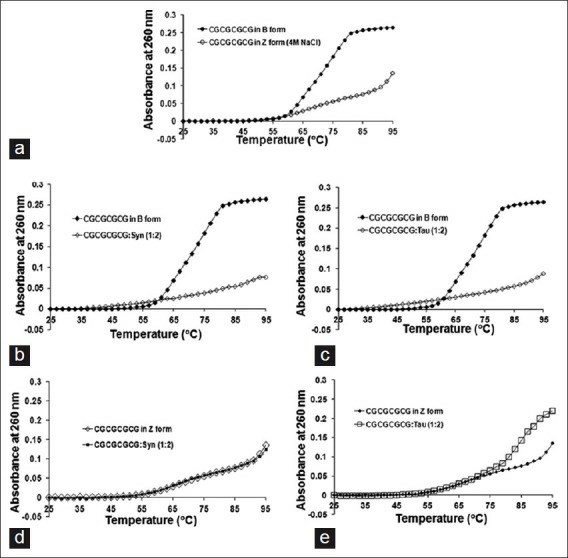Melting Temperature (Tm) Testing Service of DNA & RNA Drugs
Introduction of DNA & RNA Drug Melting Temperature (Tm) Testing
Melting temperature (Tm) refers to the temperature at which half of the DNA double strands in a given sample have dissociated into single strands, and it plays a critical role in various molecular biology applications. DNA & RNA Tm testing is a specialized technique used to determine the melting temperature of DNA and RNA molecules. It is a critical parameter in many molecular biology applications as it influences the stability and behavior of DNA and RNA structures. The Tm is influenced by several factors, including the length and composition of the DNA & RNA sequence, as well as the concentration of cations, such as sodium and magnesium ions.
 Fig. 1. Melting temperature curves of DNA & RNA complexes. (Vasudevaraju P, et al., 2012)
Fig. 1. Melting temperature curves of DNA & RNA complexes. (Vasudevaraju P, et al., 2012)
Our DNA & RNA Melting Temperature Testing Services
Creative Proteomics offers comprehensive Tm testing services. These services are designed to meet the diverse needs of researchers and industries that rely on DNA analysis.
Primer Tm Determination
Labs provide accurate Tm determination for custom-designed primers, ensuring successful PCR experiments.
Oligonucleotide Hybridization Studies
Tm testing services help researchers optimize hybridization conditions for FISH, Southern blotting, and other related techniques.
siRNA Tm Profiling
Determining the Tm of siRNA molecules ensures efficient gene silencing in RNA interference studies.
Antisense Oligonucleotide Characterization
Tm analysis aids in selecting effective antisense oligonucleotides for therapeutic purposes.
Gene Editing Guide RNA Design
Tm testing facilitates the design of guide RNA sequences for precise gene editing applications.
Process of Melting Temperature (Tm) Testing
The process of DNA & RNA melting temperature (Tm) testing involves several steps, each crucial to obtain accurate results. While variations may exist depending on the specific technique and instruments used, the general process can be summarized as follows.
Sample Preparation
Researchers provide the DNA or RNA sample of interest to the testing service. The sample can be in the form of purified DNA or RNA, primers, siRNA, or other custom DNA & RNA drugs.
Denaturation
The sample is initially heated to a high temperature to denature the double-stranded DNA or RNA into single strands.
Annealing
The denatured sample is then slowly cooled, allowing the single strands to re-anneal or reassociate. This cooling process is performed under controlled conditions.
Monitoring
During the annealing process, the changes in sample absorbance, fluorescence, or other physical properties are monitored to detect the Tm point accurately.
Data Analysis
The collected data is analyzed to determine the Tm, which corresponds to the temperature at which half of the DNA or RNA duplexes have dissociated into single strands.
Melting Temperature Testing Application Fields
The significance of DNA & RNA melting temperature (Tm) testing extends across a wide range of scientific and industrial applications.
- Primer Design in Polymerase Chain Reaction (PCR).
- PCR Optimization.
- Oligonucleotide Hybridization.
- Antisense Oligonucleotide Therapeutics.
- siRNA and RNA Interference (RNAi) Studies.
- Gene Editing Techniques.
Creative Proteomics is equipped with the latest technologies and advanced instrumentation, enabling us to conduct Tm testing at the highest level of quality. We understand that each project is unique, and we take pride in tailoring our services to meet specific requirements. You can trust us to design experiments that fit your exact needs. If you are interested in our services, please contact us for more detailed information.
Reference
- Vasudevaraju P.; et al. (2012). New evidence on α-synuclein and Tau binding to conformation and sequence specific GCFNx01 rich DNA: Relevance to neurological disorders. J Pharm Bioallied Sci. 4(2):112-117.
For research use only, not intended for any clinical use.

 Fig. 1. Melting temperature curves of DNA & RNA complexes. (Vasudevaraju P, et al., 2012)
Fig. 1. Melting temperature curves of DNA & RNA complexes. (Vasudevaraju P, et al., 2012)